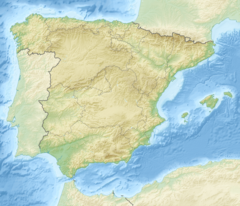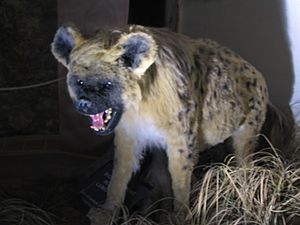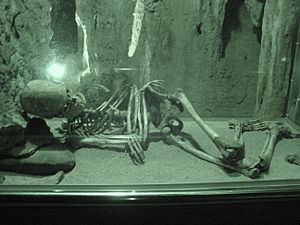Caves of Nerja facts for kids
|
Cuevas de Nerja
|
|

cave interior
|
|
| Location | Nerja, Province of Málaga |
|---|---|
| Coordinates | 36°45′42″N 3°50′45″W / 36.76167°N 3.84583°W |
The Caves of Nerja (Spanish: Cueva de Nerja) are amazing natural caves found near the town of Nerja in the Province of Málaga, Spain. These caves stretch for almost 5 kilometers (about 3 miles). They are one of Spain's most popular places to visit!
Imagine a huge natural room underground. One of the cave chambers is so big and shaped like an amphitheatre that concerts are often held there.
These caves were found again in modern times on January 12, 1959. Five friends discovered them by entering through a small opening called "La Mina." This was one of two natural ways into the cave system. Later, in 1960, a third entrance was made. This new entrance made it much easier for tourists to visit. The caves are split into two main parts: Nerja I and Nerja II. Nerja I has the "Show Galleries," which are open to everyone. They have stairs and paths, so it's easy to explore. Nerja II is not open to the public. It includes the "Upper Gallery," found in 1960, and the "New Gallery," found in 1969.
In 2012, something super exciting was announced! Scientists found cave paintings in the Caves of Nerja that might have been made by Neanderthals. These paintings could be as old as 42,000 years!
Contents
History of the Nerja Caves
Millions of years ago, about 5 million years ago, water slowly seeped into cracks in the marble rock. This water dissolved the rock, creating the huge caves we see today. Later, earthquakes and landslides changed how the water flowed inside. This led to the formation of the giant stalactites and stalagmites that make the caves so beautiful.
Scientists have found bones in the caves. These bones show that people lived here from about 25,000 BC until the Bronze Age. Amazing cave paintings from the Paleolithic (Old Stone Age) and later times have been found on the cave walls.
For about 4,000 years, starting around 25,000 BC, small groups of humans used the caves only at certain times of the year. When humans were away, cave hyenas would live there. By 21,000 BC, more people started living in the caves all year round. They developed a culture based on hunting animals in the area. The first cave paintings found in the cave are from this time. People also ate pine nuts and snails.
Until about 10,800 BC, their hunting skills got even better. They hunted more types of animals, like goats, rabbits, fish, and even sea animals. Many animal bones, shells, and fish bones from this time have been found. They also found tools made from stone and bone.
By 4500 BC, people in the area started keeping farm animals. They also began farming the land around the cave and making pottery. By 3800 BC, they were making textiles (cloth) and more advanced pottery. Parts of the cave were even used as a special place for burials.
Exploring the Cave Galleries
The Caves of Nerja are divided into different sections called "galleries." Each gallery has smaller "halls" where the cave walls, floors, or ceilings create separate areas.
The Show Gallery: What You Can See
To enter the Show Gallery, you go down an 8-meter (26-foot) flight of stairs. This leads to the Entrance Hall (Sala de Vestibulo). This is where archaeologists have dug up many ancient items. Some of these discoveries are now on display here.
From the Entrance Hall, a passage leads to the Mine Hall (Sala de la Mina) and the Hall of the Sink (Sala de la Torca). More archaeological digs happen in these areas, but they are usually not open to visitors.
Back through the Entrance Hall, you'll find the Hall of the Nativity (Sala de Belén). This hall is full of amazing calcite columns, which are natural rock formations. A skeleton found in the cave is displayed in a glass case here.
Another passage from the Entrance Hall is called the Hall of the Tusk (Sala del Colmillo). It leads down to the Hall of the Waterfall or Ballet (Sala de la Cascada o del Ballet). This is a very special place! Concerts and dance festivals are held here, and there are about 100 permanent seats for the audience.
This large cavern flows into the Hall of the Phantoms (Sala de los Fantasmas). It's named after a unique rock formation that looks like a phantom. At the end of this cavern, a large rockfall separates it from the Hall of the Cataclysm (Sala del Cataclismo). This hall is over 100 meters (328 feet) long! It's dominated by a huge central column, which is the biggest in the world. It measures 13 meters (43 feet) by 7 meters (23 feet) at its base and stands 32 meters (105 feet) tall!
Further into the Hall of the Cataclysm, you'll find the Organ Corner (Rincón del Órgano). Here, some fluted columns can be tapped to make different musical notes. It seems that ancient people might have even changed some of these columns on purpose to create specific sounds! High up in a far corner of this cave is the opening that leads to the Upper and New Galleries.
Upper and New Galleries: Hidden Treasures
The Upper and New Galleries are each divided into two halls. In the Upper Hall, you'll find the Columns of Hercules (Columnas de Hércules) and the Hall of Immensity (Sala de la Inmensidad). In the New Gallery, there are the Hall of the Lance (Sala de la Lanza) and the Hall of the Mountain (Sala de la Montaña).
These two areas contain many of the incredible cave paintings. However, these parts of the cave are not usually open to the public. Access is limited to special caving tours focused on studying the cave formations.
Cave Investigations and Discoveries
Many expeditions have explored the Caves of Nerja to learn more about them. In 1969, a narrow passage was found in the Hall of the Cataclysm. This led to an amazing discovery: the "high galleries" and the "new galleries." These areas have spectacular rock formations and prehistoric remains that visitors cannot yet see.
For many years, the Fundación Cueva de Nerja (Nerja Cave Foundation) has supported studies and research of the cave. They have a Scientific Committee with geologists, biologists, archaeologists, and paleontologists. They organize conferences, photo studies, and cultural activities.
In 2012, scientists found some organic remains linked to paintings of seals. These remains were dated to 42,000 years ago! This could mean these are the oldest known works of art ever made by humans. They might have been created by early human groups like the H11s.
A Protected Cultural Site
The Caves of Nerja are incredibly important. Just one year after they opened to tourists, they were declared a Historical Artistic Monument in 1961. This means they are a very special part of Spain's history and art. Later, in 1985, they became a Bien de Interés Cultural (Property of Cultural Interest) under Spanish law.
In 2006, the Caves of Nerja were officially declared a Property of Cultural Interest with the special category of Archaeological Zone. This shows how important they are for understanding ancient human life.
See also
 In Spanish: Cueva de Nerja para niños
In Spanish: Cueva de Nerja para niños
- Rock art of the Iberian Southern Tip




